Essay On Midsummer Nights Dream
Outline of Essay
- Introduction
- The plot of A Midsummer Night’s Dream
- Themes in A Midsummer Night’s Dream
- Shakespeare’s use of language and imagery
- A Midsummer Night’s Dream in performance
Introduction
“A Midsummer Night’s Dream” is a romantic comedy play written by William Shakespeare in the late 16th century. The play is set in Athens, Greece, and revolves around the events of the wedding of Duke Theseus and Hippolyta. The play features four interconnecting plots, involving four sets of lovers and a group of amateur actors who are trying to put on a play for the wedding.
The play is known for its fantastical and magical elements, including the fairy characters of Oberon and Titania, as well as Puck, a mischievous sprite. The play explores themes of love, jealousy, and the power of imagination, and is often considered one of Shakespeare’s most popular and enduring works.
The plot of A Midsummer Night’s Dream
A Midsummer Night’s Dream tells the story of several interwoven plots involving love, magic, and misunderstandings.
The play is set in Athens, Greece, and begins with Theseus, the Duke of Athens, planning his marriage to Hippolyta, the Queen of the Amazons. At the same time, Hermia is in love with Lysander, but her father Egeus insists that she marry Demetrius instead. Hermia and Lysander decide to flee Athens to escape her father’s wrath, and they tell their plan to Helena, who is in love with Demetrius. Helena tells Demetrius about the plan in hopes that he will fall in love with her, but Demetrius only becomes angry and sets off to find Hermia and Lysander.
Meanwhile, a group of amateur actors, including Bottom, are rehearsing a play to perform at the wedding of Theseus and Hippolyta. The fairy king Oberon and his queen Titania are also having a dispute over a young Indian boy that Titania has taken as her attendant. To help his friend, Helena, Oberon enlists the help of his mischievous servant Puck to use a magic flower to make Demetrius fall in love with her.
However, Puck accidentally puts the love potion on Lysander instead, causing him to fall in love with Helena instead of Hermia. Demetrius is also affected by the magic flower, and he too falls in love with Helena. Chaos ensues as Lysander and Demetrius both pursue Helena, and Hermia becomes jealous and angry with Helena. In the midst of all this, the fairy Puck transforms Bottom’s head into that of a donkey, and Titania falls in love with him.
Eventually, Oberon sets everything right with the help of his magic, and the lovers are reunited. Theseus and Hippolyta are married, and the amateur actors perform their plays at the wedding. In the end, the various characters make amends, and the play ends with a message about the power of love and the transformative nature of imagination and dreams.
Themes in A Midsummer Night’s Dream
There are several themes in William Shakespeare’s play “A Midsummer Night’s Dream”. Here are some of the most prominent ones:
Love is the most prominent theme of the play. The play explores different aspects of love, including romantic love, unrequited love, and forced love. The characters in the play struggle with the complexities of love, and their feelings of love often lead to irrational behaviour. The play is set in a dreamlike world, where the lines between reality and illusion are blurred.
The characters experience various dreams and illusions throughout the play, and these dreams often reveal their true desires and fears. The play features a variety of magical elements, including fairies, spells, and potions. The use of magic in the play reflects the characters’ desires to control their fate and the world around them.
It gives them the idea that things are not always as they seem. The characters often make assumptions based on appearances, but these assumptions are not always accurate. The play challenges traditional gender roles and stereotypes. The female characters in the play are strong-willed and independent, while the male characters are often foolish and easily manipulated. It portrays a world that is constantly shifting between order and disorder. The characters struggle to maintain control over their lives and their relationships, but their efforts are often thwarted by the chaotic forces of love and magic.
Shakespeare’s use of language and imagery
William Shakespeare is widely regarded as one of the greatest playwrights in history, largely due to his masterful use of language and imagery in his plays and sonnets. Here are some key aspects of Shakespeare’s use of language and imagery:
Shakespeare often uses metaphors and similes to convey complex ideas or emotions vividly and memorably. For example, in “Romeo and Juliet,” Romeo compares Juliet to the sun, saying, “Arise, fair sun, and kill the envious moon, who is already sick and pale with grief.” Shakespeare was known for his clever wordplay and use of puns, which added humour and depth to his works.
For example, in “Hamlet,” the title character famously says, “To be or not to be, that is the question,” playing on the double meaning of “be” as both existence and acting. Shakespeare often used vivid imagery and symbolic language to create powerful and lasting impressions in his audience’s minds. For example, in “Macbeth,” the character of Lady Macbeth is associated with the image of blood, which represents her guilt and the violence of the play.
Shakespeare’s plays are written primarily in blank verse, which is unrhymed iambic pentameter. This rhythmic pattern gives his writing a natural flow and musical quality and allows him to vary the length and pace of his lines for dramatic effect. Shakespeare’s characters are often defined by their language, which reveals their personalities, motivations, and inner thoughts. For example, in “Othello,” the villainous Iago is known for his manipulative language and ability to turn others against each other.
A Midsummer Night’s Dream in performance
“A Midsummer Night’s Dream” is one of William Shakespeare’s most beloved and frequently performed plays. It is a comedy that tells the story of four young lovers who find themselves lost in a magical forest, and the mischievous fairies who interfere in their romantic pursuits.
Performances of “A Midsummer Night’s Dream” can vary greatly in terms of staging, interpretation, and overall tone. Some productions may emphasize the play’s romantic elements, while others may focus more on its fantastical elements.
Here are some common features of performances of “A Midsummer Night’s Dream”. The play is set in a magical forest, and many productions use elaborate sets, lighting, and costumes to create a fantastical atmosphere. Some productions may also use special effects such as smoke, fog, or projections to create a sense of enchantment.
It is a comedy, and performances often emphasize its humorous elements. The play features mistaken identities, miscommunications, and other comedic situations, and many productions play up these moments for laughs. Many productions of “A Midsummer Night’s Dream” incorporate music and dance into the performance. This can range from simple instrumental accompaniment to elaborate musical numbers and choreography.
The fairies in the play are often depicted with elaborate costumes and makeup, including glitter, wings, and other magical details. The human characters may also wear period-appropriate costumes or modern clothing, depending on the production. Productions of “A Midsummer Night’s Dream” may feature actors of different genders, races, or ages in various roles. Some productions may also gender-swap certain characters or make other creative casting choices to bring a fresh perspective to the play.
FAQ’s
What is the setting of “A Midsummer Night’s Dream”?
The play is set in and around Athens, Greece, and a nearby forest.
What is the role of the Mechanicals in “A Midsummer Night’s Dream”?
The Mechanicals are a group of amateur actors who are hired by the Duke of Athens to perform a play at his wedding. They are presented as bumbling and inept, but their enthusiasm and sincerity endear them to the audience. Their play-within-a-play serves as a comic foil to the main plot of the play and highlights the themes of illusion and reality. The play is set in and around Athens, Greece, and a nearby forest.
Download the Pdf of Essay On Midsummer Nights Dream

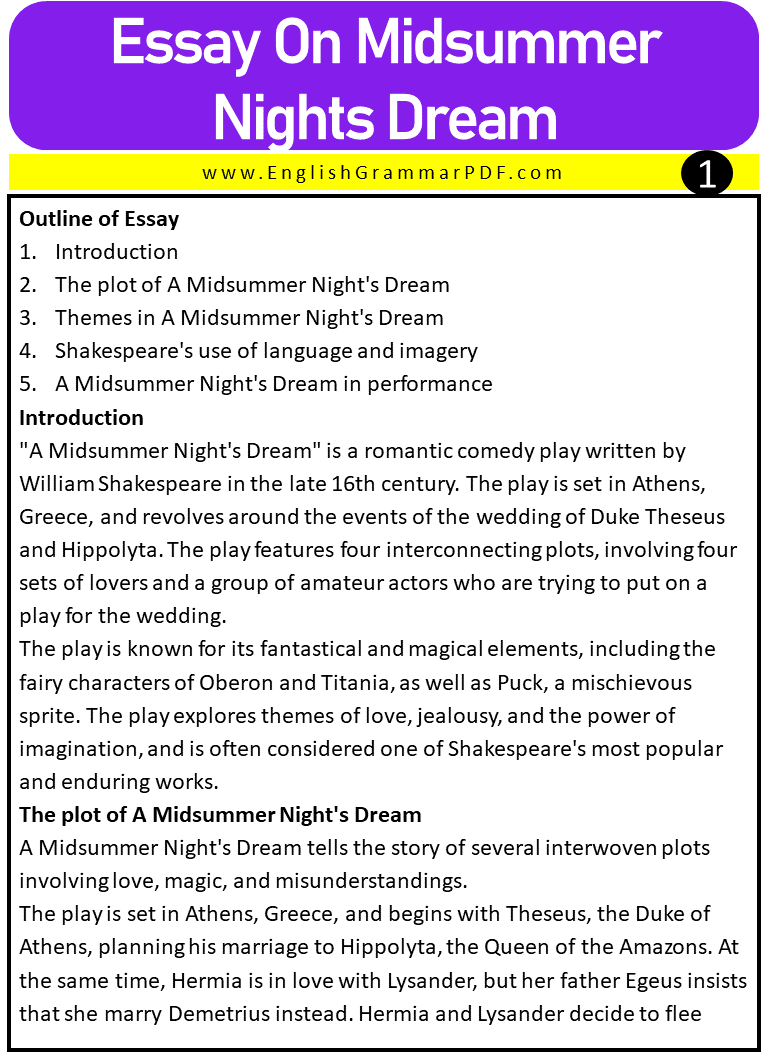
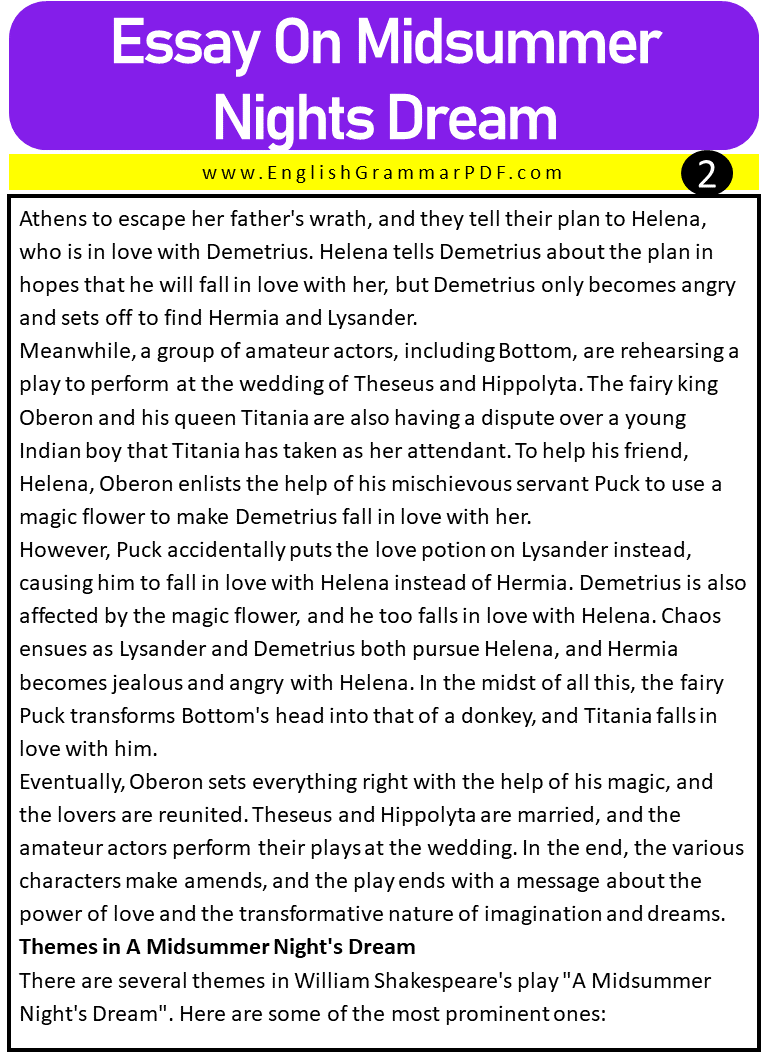
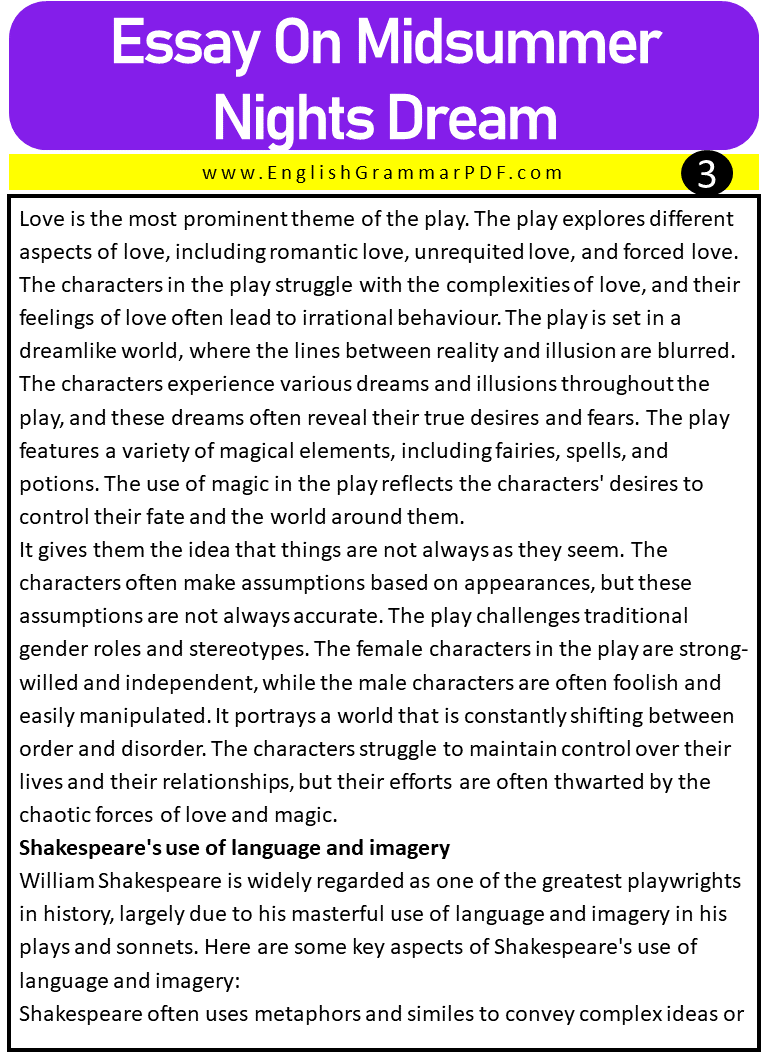
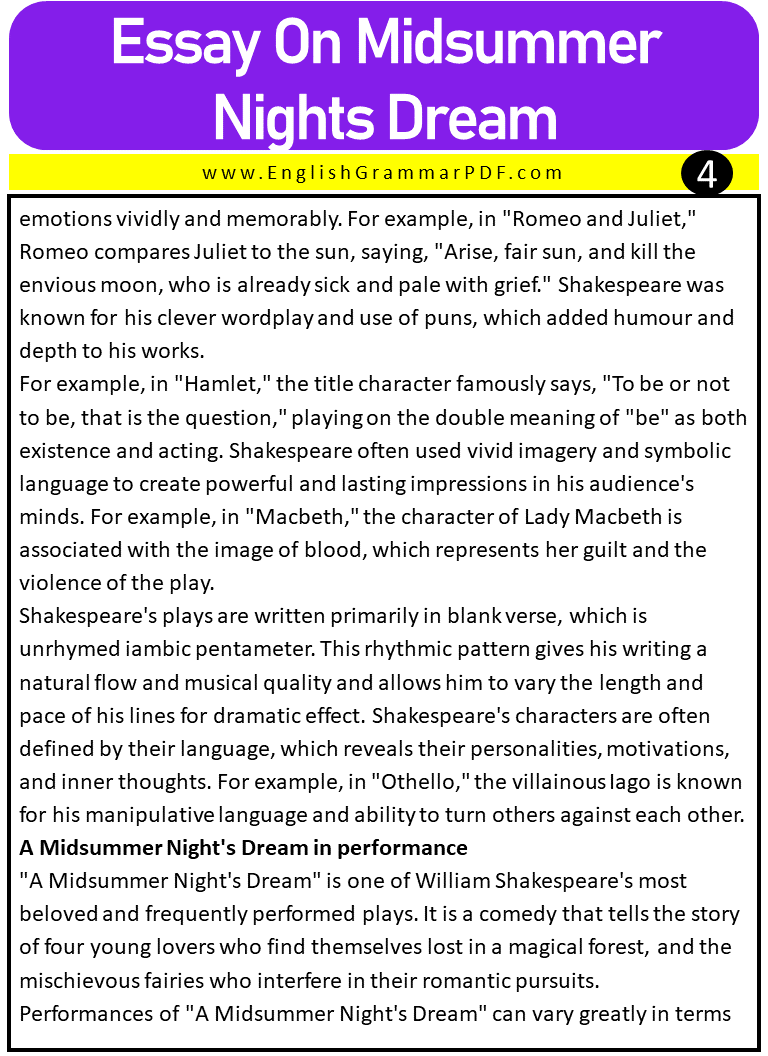
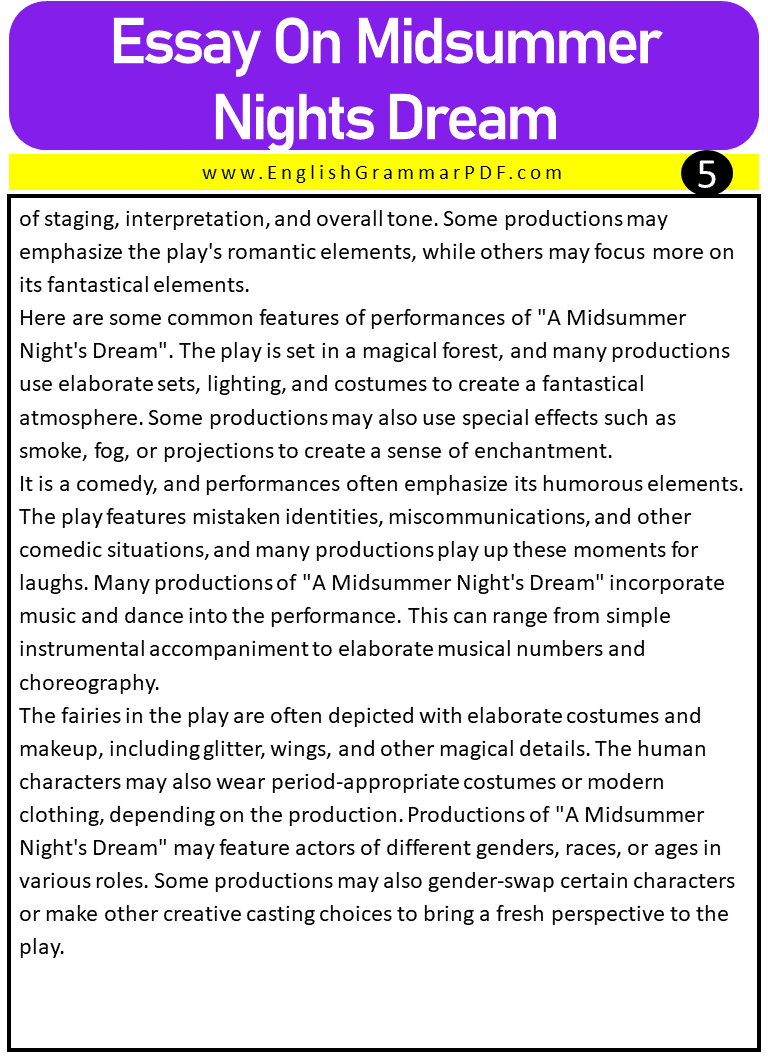
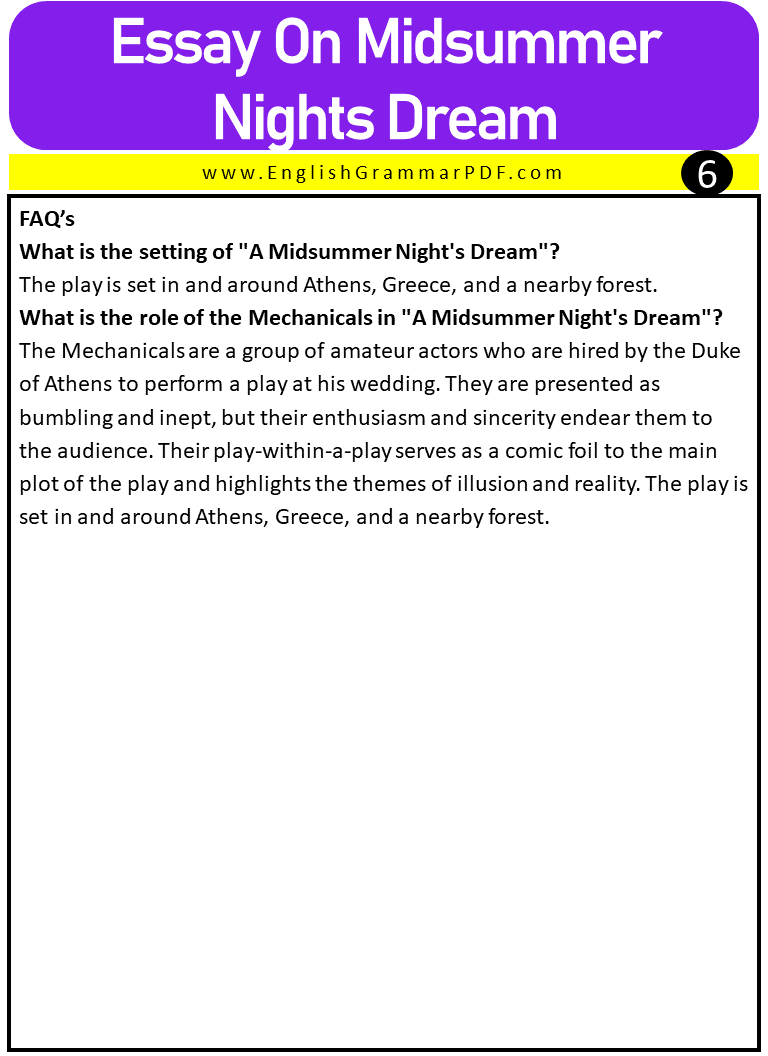
MORE ESSAYS:


